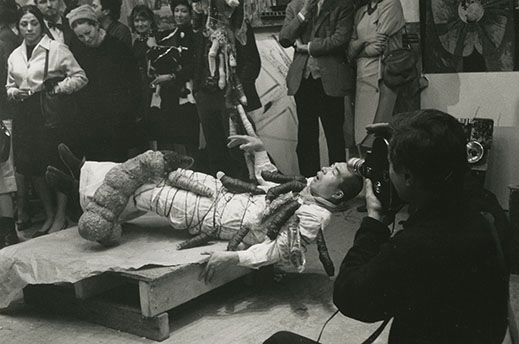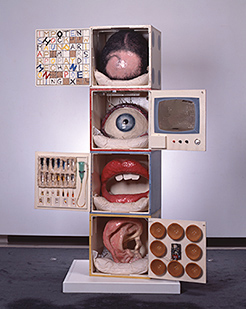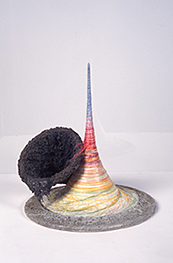 |
Focus features two in-depth reviews each month of fine art, architecture and design exhibitions and events at art museums, galleries and alternative spaces around Japan. The contributors are non-Japanese art critics living in Japan. |
|
|
 |
 |
 |
Your Portrait: A Tetsumi Kudo Retrospective
Christopher Stephens |
 |
 |
|
|
Tetsumi Kudo, Happening: Philosophy of Impotence, Cinéma-Studio de Boulogne, Paris, February 1963
Photo: Hiroko Kudo |
Though not completely forgotten, Tetsumi Kudo's work has been neglected for many years. This is perhaps due to the grotesque appearance and overly serious themes of his art, and to the fact that he was a true outsider who spent most of his professional career in Paris. Your Portrait: A Tetsumi Kudo Retrospective (running through January 19 at the National Museum of Art, Osaka), a sprawling reexamination of Kudo's multifaceted activities, does its best to address this oversight and return the artist to his rightful place in art history. Including many pieces which, as they were made and sold in Europe, have never been shown in Japan, as well as a host of rare photographs and other documents from the Kudo family archive, the exhibition is the largest single collection of the artist's work ever assembled.
Born in Osaka in 1935, Kudo spent most of his childhood in Aomori and Okayama before moving to Tokyo to attend Tokyo National University of Fine Arts and Music (Geidai) in 1953. By the time he began exhibiting his work publicly in the late '50s, Kudo had already arrived at lifelong themes like radiation, reproduction, and impotence, showing more interest in scientific theories than artistic concepts. Focusing primarily on sculpture, Kudo wound huge amounts of knotted string around wooden frames, hammered hundreds of nails into tree roots and branches, and entangled scrub brushes in colorful plastic tubes and wire to create eerie objects with the quality of a totem. Noted critic Yoshiaki Tono called the approach "anti-art," a word which subsequently came to define an entire movement in Japanese art.
While many artists would have jumped at the chance to study in Paris, it was with indifference that Kudo accepted a scholarship and moved to the city in 1962. In his view, there was nothing to learn from European culture; if anything, it was the Europeans who needed to be "taught a lesson." Yet Kudo remained in France for the next quarter-century, only returning to live in Japan near the end of his life in the late 1980s.
While in Japan, Kudo had given several "production performances" (live painting demonstrations sometimes accompanied by music), and not long after arriving in France he was introduced to Jean-Jacques Lebel, a leader in the emerging Happening movement. Lebel invited Kudo to make his Paris debut in an event called To Conjure Away the Spirit of Catastrophe. In a performance titled Philosophy of Impotence, Kudo, clad in a white shroud tightly bound to his body with string and covered with phallic objects, held a huge penis or pupa in the air as if it were a religious idol while he hobbled around and fell to the floor of the space.
 |
|
 |
|
|
|
Tetsumi Kudo, Your Portrait (1963), Takamatsu City Museum of Art
Photo: Akira Takahashi |
|
Tetsumi Kudo, L'amour (1964), Kurashiki City Art Museum |
This led him to a series of other controversial pieces with titles like Instant Sperm and Bottled Humanism, in which Kudo sliced open the abdomen of a baby doll and stuffed it into a bottle before shaking it up with red liquid to make a cocktail. More than simple provocations, these actions were meant to convey the artist's belief that the human race, and in particular European civilization and Christian culture, had much to answer for in regard to its commodification of natural resources and wanton abuse of the earth.
At the same time, Kudo began to develop several series of sculptural works that touched on similar concerns. He combined artificial body parts (eyes, noses, skin, brains, and most prominently, male genitalia) with clocks, thermometers, ampules of medicine, cooking utensils, and electronic components. These were often planted in a small garden or hothouse alongside partially melted plastic flowers, neatly arranged inside a stack of huge hollow dice, or confined to a fluorescent-colored birdcage or fish tank. The vision was decidedly apocalyptic and reminded many Western viewers of wartime atrocities and the horrors of nuclear war. Today, Kudo's work seems even more prescient in light of recent events in Fukushima.
Kudo's titles, which he called "one-line essays," are nearly as stunning and suggestive as his works. Often written in French or English (or a combination of the two) without a Japanese equivalent, they include epic constructions like Distribution Map of Impotence and the Appearance of Protective Domes at the Points of Saturation; Human Bonsai -- Freedom of Deformity -- Deformity of Freedom; Wandering Jomon Spermatozoids under the Yamanaka Sky; and The Structure of the Jomon Period = The Structure of the Emperor System = The Structure of Contemporary Japan (On the Structure of the Emperor System -- The Sacred Black Hole). But Your Portrait was the title Kudo returned to again and again, first as an indictment of humanity as a whole, and later, after the artist underwent a series of crises, to expose his own personal inadequacies.
Kudo's works are not as shocking as they once were, and stylistically they tend to verge on kitsch, but there is also something eminently human and winningly handmade about them. Unlike so much contemporary art, these are clearly the efforts of a man who cared deeply about and devoted himself to expressing his unique vision at any cost. For this alone, Tetsumi Kudo deserves to be rediscovered and reinstated as a key figure in postwar art.
|
|
|
 |
|
 |
|
|
|
Tetsumi Kudo, Meditation in the Endlesstape of the Future<-->Past (1979), Aomori Museum of Art
Photo: Yoshitaka Uchida (Nomadic Studio)
|
|
Tetsumi Kudo, Valsez avec le trou noir! (1982), private collection
|
All photographs © ADAGP, Paris & JASPAR, Tokyo, 2013 and provided courtesy of the National Museum of Art, Osaka; unauthorized reproduction prohibited.
|
|
|
|
 |
Your Portrait: A Tetsumi Kudo Retrospective |
 |
The National Museum of Art, Osaka |
 |
2 November 2013 - 19 January 2014
Next year the exhibition will also travel to the Museum of Modern Art, Tokyo (4 February - 30 March 2014) and the Aomori Museum of Art (12 April - 8 June 2014). |
|
|
 |
 |
Christopher Stephens
Christopher Stephens has lived in the Kansai region for over 25 years. In addition to appearing in numerous catalogues for museums and art events throughout Japan, his translations on art and architecture have accompanied exhibitions in Spain, Germany, Switzerland, Italy, Belgium, South Korea, and the U.S. His recent published work includes From Postwar to Postmodern: Art in Japan 1945-1989: Primary Documents (MoMA Primary Documents, 2012) and Gutai: Splendid Playground (Solomon R. Guggenheim Museum, 2013). |
|
 |
|